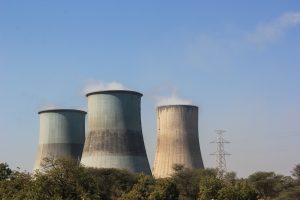On the afternoon of August 2, a small hamlet in India’s Rajasthan state bore witness to the on-ground challenges that impede India’s gradual transition to clean energy. In the Chhoti Sarwan area of Banswara district, tribal protesters – men, women and children – violently clashed with the police for three hours over a proposed nuclear plant. Many were injured as the police removed protesters from the area.
Prime Minister Narendra Modi will lay the foundation stone for the plant in the coming month.
Spread over 660 hectares, the proposed Mahi-Banswara Rajasthan Atomic Power Plant project, to be built at a cost of approximately $6 billion, will produce 2.8 gigawatt (GW) of power. It will also displace over 3,000 people from eight villages, which will be vacated and demolished. While some of the displaced people have been compensated monetarily and have been provided with alternate land in nearby locations, others are demanding jobs in the power plant, citing job losses tied to the project. Local politicians say that people are also concerned about the environmental impact the plant can have on their land, water, and air. The displaced were unaware of the exact nature of the project for which they were asked to part with their land.
The protests may have shown local opposition, but the police actions clearly displayed the Indian state’s unwavering resolve to push past objections and achieve its clean energy goals for 2032 and 2070.
Indeed, nuclear energy has a critical place in India’s plans to implement a diverse portfolio of its energy mix policies nationally and within individual states to improve energy efficiency, develop clean energy sources, and prepare for the impacts of climate change. Official assessments have indicated that without substantial investment in nuclear as well as other green energies, India’s net-zero emission goals will not be met by 2070. The government seems to have prioritized setting up nuclear plants.
Anushakti Vidhyut Nigam, a joint venture company that will build the plant in Rajasthan, is looking to develop nuclear power plants in Tamil Nadu, Karnataka, Jharkhand, Chhattisgarh, and Gujarat among other states and is in the process of identifying potential sites alongside getting requisite approvals. It plans to add 60 GW of green energy capacity by 2032.
India’s current nuclear power capacity is 7.4 GW. The goal is to reach 13 GW by 2029, and 22.4 by 2032. India plans to commission a nuclear power reactor every year until its goal is reached.
That, however, will not be without challenges, simply because of the lack of honest conversations and the inability of the government to bring the people onboard along with its mission. This has fueled an intense level of opposition within the country against nuclear power plants, with people citing the dangers of reliance on nuclear energy by pointing to the Fukushima Daiichi accident in Japan in 2011. However, people’s persistent opposition has been stonewalled by the government.
The operationalization of the Kudankulam nuclear plant in Tamil Nadu state, the biggest in the country built with Russian assistance, is a case in point. The first unit of the six-unit plant was made operational in 2014 and the second unit in 2016 after years of protests against it. In 2012, then-Prime Minister Manmohan Singh put the onus on American and Scandinavian NGOs for fueling protests. The protesters, mostly belonging to the fishing community living in the vicinity of the plant, who are apprehensive of the impact of the plant on their livelihood, were slapped with stringent anti-sedition laws before the Indian Supreme Court provided temporary relief in 2022.
Two more plant units are coming up in Kudankulam with Russian assistance. In December 2023, India and Russia signed agreements on the construction of the last two units in Kudankulam. The fully operational plant will produce 6 GW of energy.
India and Russia are reportedly working on a $1.2 billion deal for the supply of nuclear fuel and core components. New Delhi is also looking at the possibility of forming a joint venture with Rosatom, the Russian state-run parent of nuclear fuel company TVEL JSC, for the manufacturing of nuclear fuel for the plant in India. Negotiations are ongoing with the Russians for building six more nuclear power units. Cooperation in the civilian nuclear sphere doesn’t fall under the U.S. sanction regime on Russia for its invasion of Ukraine.
India’s emphasis, however, is on indigenous technology and advancing the country’s three-stage nuclear program. On March 4 this year, the process of core-loading the indigenous prototype fast breeder reactor (PFBR) at the Madras Atomic Power Station in Kalpakkam, Tamil Nadu was started. The much-delayed project which has seen cost overruns, has brought the country to the cusp of stage two, which will be powered by uranium and plutonium. Stage three will use thorium to produce nuclear power and gain energy self-sufficiency. India has vast reserves – about 1.07 million tonnes – of the metal.
India’s budget for 2024 unveiled the government’s plan to involve the private sector in setting up smaller reactors in place of traditional large-scale nuclear plants. A R&D funding of $11.9 billion for the purpose has been announced by the government. There is, however, still a long road ahead. With 22 operating reactors, India is way behind the curve. For reference, China has a total of 55 reactors with a total net capacity of 53.2 GW as of April 2024. In the last 10 years, Beijing has added 34 GW of nuclear power capacity.
Further, experts opine that India’s present ambitious pace may pose additional challenges of nuclear waste management. Lack of adequate resources, the politics around the setting up of the new plants, and the absence of transparent engagement process and conversations with key stakeholders may create additional roadblocks in India’s pursuit of clean energy goals and climate action.

































